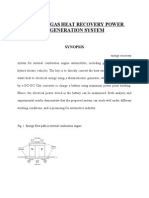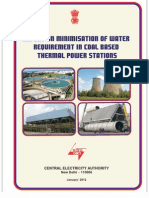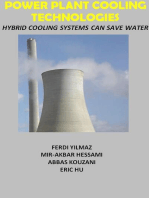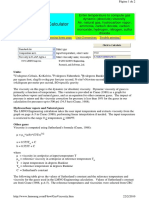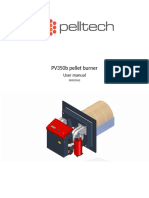Lawrence F. Drbal: Ihsas
Lawrence F. Drbal: Ihsas
Uploaded by
langcvCopyright:
Available Formats
Lawrence F. Drbal: Ihsas
Lawrence F. Drbal: Ihsas
Uploaded by
langcvOriginal Description:
Original Title
Copyright
Available Formats
Share this document
Did you find this document useful?
Is this content inappropriate?
Copyright:
Available Formats
Lawrence F. Drbal: Ihsas
Lawrence F. Drbal: Ihsas
Uploaded by
langcvCopyright:
Available Formats
i
!
i
i
1
INTRODUCTION
Lawrence F. Drbal
one only has to experience a power outage to be reminded of
how much we rake electricity for granted. our lighting.
heating, and cooling systems no longer operate. Computers.
televisions. videos, and other communication systems be-
come unusable. Trafiic conaol lights become Useless: eha-
commercial buildings
become virmally inoperable.
tors no longer move
people;
and indusmes. schools. and
We are clearly dependent on elecmcity for most of OUT
everyday activities. This dependence also demonstrates why
electricity is regarded as one of the most significant sociolog-
ical inventions of the 20th century. Although the United.
States and our industrialized neighbors enjoy the full benefits
of electricity, the worlds developing nations do not. Supply-
ing electricity to these areas under various economic, envi-
ronmental, social, and political consuaints will be Oneof the
major challenges inthe 21st century.
nomic conditions in the conceptual and planning phases of
Power producers
must consider the l o c a l social and ece
all projects. Their engineering decisions must reflect an
awareness and knowledge ofthe best equipment and systems
available. The final product. the electrical generation and
distribution system, must reflect mpnsi bl e application of
economic and engineering principles and of thoughtful rec-
ognition of social and environmental concerns. The ap-
proach Black & Veatch has used to meet these challenges is
described in this book.
tures prepared
by Black & Veatch insmctors for use in
Power Plum
Engineering
originated from a sene$ of lec-
teaching steam power plant design through the University of
Ihsas. The material was later expanded by the fumfor use
i n teaching its own en,$neen and technical specialists. As a
book was
developed
from the system design engineers
per-
definitive text on the design of
coal-fueled power plants,
this
Spective. Inother words. the book describes the approach the
engineer uses to design and integrate the plant systems and to
SPeClfy performance and design requiremenrs. but it does not
address the detailed design of the equipment. which is usu-
ally done by the manufacturer.
application of the major areas of power plant related
Power Plant
Engineering includes both theory and practi-
ranging from permining and engineering economics
Io coal and limestone handling. from design processes to
plant thermal heat balmces. Although the focus of the text is
On coal. the book reviews .dl major power-senerating tech-
nologies. giving particular emphasis to current approaches.
It funher defines and analyzes the features of various plant
systems and major components, and discusses promising
emerging technologies.
pulverized coal-fueled power plant from theory through the
The text presents a full development of the design of a
details of application.
Figure 1-1 depicts a modem pulverized coal-fueled elec-
trical generation facility that uses the most commonly en-
countered Rankine-based thermodynamic cycle. This facil-
ity generates electricity by producing steam in a s t e a m
generator and expanding the steam through a turbine genera-
tor. Thesteam is then condensed in a condenser, and the
condensed liquid is used again in the steam generator.
ship between
engineering
design and economic costs and
Chapter 2.
Engineering
Economics, presents therelation-
provides the designer with economic analysis concepts to
idenufy the least-cost options among alternatives. Chapter 3,
Thermodynamics and Power Plant Cycle Analysis, presents
based cycle and procedures for a simplified heat balance
a method for analysis and evaluation of the modem Rankine-
analysis.
Chapter 4. Fossil Fuels. provides information on reserves.
production, consumption, specific properties, and economics
coal, which supplies over 50% of the fuel for electrical gene-
for oil. natural gas, and other major fossil fuels, including
ration in the United States.
though barges and trucks are also used. The coal handling
Coal is usually delivered to the facility by unit nai ns, al-
system unloads the coal, then stacks. reclaims, crushes. and
conveys it to storage silos near the steam generator. Coal and
limestone handling system designs are discussed in Chapter
5. Coal is fed fromthe storage silos, pulverized to a powder.
and blown into the steam generator. Within the steam genera-
combustion energy is used to produce stem. The charac-
tor, pulverized coal is mixed with ai r and combusted. and the
quantities, and stem generator efficiencies are discussed in
teristics of the combustion process. air requirements. flue gas
Chapter 6.
steam as i t proceeds through the cycle. Chapter 7 discusses
The steam generator produces, superheats. and reheats
stem generator system and component design. steam tem-
perature control. and pulverizer design.
The steam turbine generator. addressed in Chapter 8.
I
COAL HANDLING SYSTEM
TURBINES
CIRCULATINQ WATER SYSTEM
POSTCOMBUSTION CLEANUP SYSTEM
STEAM GENERAllON SYSTEM
SO1 REMOVAL
SYSTEM
1
-
AIR
HEATER
A STACK
FORCED DRAFT FAN
-
DRAFT FAN(S)
FLY ASHTO LANDFILL
converts the thermal energy of the superheated and reheated
steam from the steam generator to electrical energy. The
sream turbine converts the stem thermal energy to rotating
mechanicd energy, and the generator, which is coupled to
the stezm turbine. converts the mechanical enerxy to elecm-
cal snergy.
Steam exhausted from the low-pressure section of the
steam Nrbine is condensed to liquid in the condenser. The
condensed liquid is moved from the condenser by conden-
sate pumps through low-pressure regenerative feedwater
heaters to a deaerator. Boiler feed pumps move the deaerated
liquid through high-pressure regenerative heaters to the
steam generator. Extraction steam from the steam nubine is
supplied to the low- and high-pressure feedwater heaters for
the liquid regenerative heating, which improves cycle effi-
ciency. These steam cycle heat exchangers, whch include
the condenser, deaerator, and feedwater heaters. are dis-
cussed in Chapter 9. Design, performance, and arrangement
requirements are addressed, as well as design parameters for
steam turbine water protection.
Forced draft fans supply combustion air to the steam
generator, and the primary ai r fans transport pulverized coal
into the steam generator. hduced draft fans remove the flue
gases from the steam generator and exhaust them to the plant
stack. Chapter IO discusses the specific fan design require-
ments for the combustion ai r and Rue gas exhaust, including
performance. sizing requirements. operating characteristics.
and fan selection.
J ust as fans move air, pumps move liquids through the
plant. Chapter 11 focuses on pumps (primarily centrifugal
pumps) used in power plant applications, addressing circu-
lating water, condensate. and boiler feed pumps. Pump per-
formance. sizing requirements, operating characteristics,
and specific considerations for selection are addressed.
Cooling water for the condenser is supplied by the circu-
condenser and rejects it to cooling towers or another heat
lating water system, which lakes the heat removed from the
Sink, such as a cooling lake. Chapter 12, Circulating Water
Systems. addresses the circulating water system design, sys-
tem and component design requirements, arrangements. per-
fOrmance requirements, material considerations. and perfor-
mace optimization of cooling towers with the condenser.
cycle performance is affected
by numerous design and
Chapter
13, Cycle Performance Impacts. describes how
OPrating parameters such as main steam and reheat stem
Pressure and temperature, steam turbine back pressure, num-
ber of feedwater heaters. feedwater heater design parame-
a d superheat and reheat temperature spray flows.
steam cycle mass and energy balances. The use of a steam
cycle performance impacts x e reflected in changes in
generator thermal kit is dso demonstrated.
treatment for removal of fly ash particulates. sul-
Combustion gases exiting the steam generator require
fur dioxide. md nitrogen oxides by the plant pollution con-
systems before the gases are released through the plant
exhaust st3Ck. Environmcntal regulations included in the
i nrroducnon 3
Clean Air Act of 1970 and subsequent 1977 and 1990 iunend-
ments have established emissions limits for particulate mat-
ter. wlfur dioxide, and niuogen oxides. Chapter 14, Power
Plant Atmospheric Emissions Control, summarizes current
air emission regulations. emission reduction technologies,
and emission monitorins systems.
Chapter 15. Water Treatment, addresses the proper treat-
ment and conditioning of water for the multirude of uses
in power plant processes. This chapter provides basic in-
formation on water technology, principal rypes of treaunent
considerations and techniques applicable to steam power
and conditioning equipment. and the more important design
tion, treatment. and disposal of liquid and solid wastes.
Coal-fueled power plants also require systems for collec-
Liquid wastes may include cooling tower blowdown. ash
transport water. demineralizer regeneration chemicals, sulfur
dioxide removal system wastewater, and coal pile runoff.
Solid wastes include stem generator bottom and Ry ash and
combustion gas desulfurization solid wastes. Chapter 16dis-
cusses the current federal and state regulations for liquid and
solid wastes, as well as treatment and disposal systems.
Power plants not only produce energy: they also use
electrical energy to conml and power the various systems in
theplant. Chapter 17. Electrical Systems, addresses some of
the important design considerations for the auxiliary electri-
cal systems that power the coal handling, feedwater, conden-
sate, circulating water, combustion air, sulfur dioxide re-
moval, and padculate removal systems. Chapter 17 also
describes the uansmission systems used to transmit electri-
cal energy to the end user.
plant operation for the reliable and
efficient production of
The plant control system enables the operators to direct
electrical energy. Chapter 18, Plant Control Systems. pre-
sents an overview of the plant control system, its functions,
and the type of control equipment used in a modem coal-
fueled electrical generating facility
ments for
site and plant arrangements.
Site arrangements
Chapter
19. Sire/Plant
Arrangement,
discusses require-
show the locations of major power plant facilities, utilities
and facilities entering and exiting the site. the interconnec-
tions of major areas on the site. and traffic panems. Plant
arrangements define the physical arrangement of the build-
ings on the site and the significant equipment within the
buildings: locations and spacings of support columns: and
locations of wdls. Roors, doors. etc.
Although coal is the source of Fuel for over 50% of the
electrical generation in the United States. natural 93s is
incressin& used with combustion turbines, in either simple
or combined cycle applications. N3Iural gas. used in a mod-
ified Brayton thermodynamic cycle (Chapter 3). supplies
about l0"o of the electrical generation in the United States.
Chapter 10. Combustion Turbines. discusses combustion tur-
bine and combined cycle technology. its advantages. and
current syskm design requirements.
Fluidized bed combustion has emerged :1s a iensible alter-
pIanrS.
4 Power Planr & ~~i n r mn , q
native to pulverized coal steam generators A solid bed of
fuel (such as coal) is fluidized by an upward flow of air at a
velocity sufftcient to expand the bed. Combustion takes
place wi thi the bed under either atmospheric or pressurized
conditions. Chapter 21. Fluidized Bed Combustion. dis-
cusses this technology, its advantages and &sadvantages in
comparison to pulverized coal designs, and the current flu-
idizing bed approaches (bubbling bed and circulating bed).
Important system design requirements. supponing equip-
ment, steam temperature control. and fuel requirements are
also addressed.
Chapter 22, Resource Recovery, describes the use of
energy production. Technologies that convert waste to elec-
municipal and agri cul d solid waste as fuel for electrical
trical energy enable resource recovery of municipal wastes,
landfill volume reduction, material recycling, and energy
recovery by burning waste in steam generators to produce
electricity. The chapter discusses these technologies. basic
designs, commercial availability, fuels, and cost and perfor-
mance data.
Nuclear power, discussed in Chapter 23, supplies about
20% of theelectricity generated in the United States and 19%
of the electricity generated worldwide. Current boi i g water
and pressurized water designs are discussed, including the
supporting fuel cycle and radioactive waste management.
Future designs for large revolutionary reactors and smaller
passive reactor designs are presented as well.
plete without a discussion of future or emerging technologies
No textbook on power plant engineering would becom-
for electrical energy production. Chapter 24, Emerging
Technologies, presents this evaluation. Technologies are pre-
sented for fossil fuel (gasification combined cycle, magneto-
mass, ocean, and geothermal); energy storage (battery and
hydrodynamics, and fuel cell); renewables (solar, wind, bio-
compressed air); and nuclear (including fusion).
gether. Chapter 25, Power Plant Planning and Design, pre-
The remaining two chapters tie the design process to-
sents the planning and design process, which vaies with
specific financial, engineering, environmental, and other
plant requirements. Th~s process may involve special studies.
such as fuel supply, system planning, siting evaluations,
transmission planning. and other analyses. early in the proj-
ect development. Design engineering includes conceptual
design. which suppons permitting and licensing activities,
and detailed design, which determines the technical require-
equipment procurement and
consmction specifications. Es-
ments for
all plant systems
and components and supports
sential project control activities include critical path schedul-
ing of engineering and plant consmction, cost control. de-
sign control, and construction control.
Chapter 26 discusses essential permits and approvals and
the requirements for satisfying the environmental review
processes applicable to construction and operation of an
electrical generation facility, a critical first step. Chapter
26 gives generic descriptions of thepermits and approvals
typically required for fossil-fueled uni ts in the United States.
Power Planr Engineering is the result of over 80 years of
successful utility engineering by Black & Veatch and more
than SOyears of power plant engineering. design, and con-
struction worldwide. This book may be the most complete
reference source available. offering information that is prac-
tical and proven in the field. This source is intended to
become the standard in the professional engineer's library as
the primary source of information on steam power plant
generation systems.
1
(1
EDITOR'S NOTE ON THE STYLE OF MIS BOOK
As stated previously, this text was authored and supported by
many experienced Black & Veatch engineers and specialists.
In all cases, the styles of the individual authors were retained
as much as possible, and no attempt was made to reconcile
the diversity of approaches. Every effort has been made to
use engineering codes and standards that are current as of
publication. Readers should consult these publications di-
rectly when using information for design purposes. 4
You might also like
- 1997 Seadoo Service Shop Manual PDFDocument372 pages1997 Seadoo Service Shop Manual PDFlucas100% (4)
- Corrosion Technology: Cathodic and Anodic ProtectionDocument36 pagesCorrosion Technology: Cathodic and Anodic Protectionsohrab25100% (1)
- ProFlowEliminatorCertifiedManual PDFDocument24 pagesProFlowEliminatorCertifiedManual PDFintermountainwaterNo ratings yet
- Uni AssignmentDocument10 pagesUni AssignmentIt's MaharNo ratings yet
- 04.section I - Steam, Its Generation & Use, 41 - EdDocument193 pages04.section I - Steam, Its Generation & Use, 41 - EdMayur Patel100% (1)
- An ISO 9001:2008 Certified InstitutionDocument55 pagesAn ISO 9001:2008 Certified InstitutionA AswinNo ratings yet
- Topic 2 - Simple Ideal Vapor Power CycleDocument14 pagesTopic 2 - Simple Ideal Vapor Power CycleTheodore BaaNo ratings yet
- Waste Heat To Power Systems PDFDocument9 pagesWaste Heat To Power Systems PDFWilson FigueiraNo ratings yet
- Habeeb Report Chapter 1Document6 pagesHabeeb Report Chapter 1mutencoNo ratings yet
- Tharmal Power Plant ReportDocument27 pagesTharmal Power Plant ReportAlankar MishraNo ratings yet
- Iv Ii Ppe Unit IDocument94 pagesIv Ii Ppe Unit IDeepakNo ratings yet
- Thermal Power StationDocument16 pagesThermal Power StationDinesh Karthik VithiyananthNo ratings yet
- A Seminar Report On: "Thermal Power Plant "Document61 pagesA Seminar Report On: "Thermal Power Plant "RAMAN100% (1)
- Thermal Power PlantDocument34 pagesThermal Power PlantRama Krishna KariNo ratings yet
- Steam Power Plant: Department of Mechanical Engineering, GCE, RamanagaraDocument143 pagesSteam Power Plant: Department of Mechanical Engineering, GCE, RamanagaraSrikanth Kabbal MNo ratings yet
- Organic Rankine Cycle Power PlantDocument6 pagesOrganic Rankine Cycle Power PlantPower PowerNo ratings yet
- ASME GT2011 45736final LibreDocument8 pagesASME GT2011 45736final LibreGaluh MuhendraNo ratings yet
- تقرير مادة نظم القدرةDocument12 pagesتقرير مادة نظم القدرةHassan allaNo ratings yet
- 7.1 Thermal Power StationsDocument16 pages7.1 Thermal Power Stationsمصطفى العباديNo ratings yet
- Me 200 - 6426Document12 pagesMe 200 - 6426SHARJEEL MUNAWARNo ratings yet
- Optimization of Energy Plants Including Water/lithium Bromide Absorption ChillersDocument23 pagesOptimization of Energy Plants Including Water/lithium Bromide Absorption ChillersIgor Maciel O. SilvaNo ratings yet
- Lec.01 2 Introduction TPPDocument48 pagesLec.01 2 Introduction TPPM Danyal AslamNo ratings yet
- Exhaust Gas Heat Recovery Power GenerationDocument52 pagesExhaust Gas Heat Recovery Power GenerationabhinavkarthickNo ratings yet
- تقرير مادة نظم القدرةDocument11 pagesتقرير مادة نظم القدرةHassan allaNo ratings yet
- Thermal EngineeringDocument10 pagesThermal Engineeringlokeshdhangar842No ratings yet
- 0212075901-22-MSN20212208-2021-RP4B-01-Materi 1 Pendahuluan Vapor Power SystemsDocument10 pages0212075901-22-MSN20212208-2021-RP4B-01-Materi 1 Pendahuluan Vapor Power SystemsAnd TransNo ratings yet
- ASME90 GT 335 BollandDocument9 pagesASME90 GT 335 Bollandank_mehraNo ratings yet
- Waste Heat Recovery Power Plant - Cement PlantDocument7 pagesWaste Heat Recovery Power Plant - Cement PlantknsaravanaNo ratings yet
- Steam Power PlantDocument30 pagesSteam Power PlantIAN MIGOTNo ratings yet
- Report PDFDocument12 pagesReport PDFShailendra RajputNo ratings yet
- Lec.01 Introduction TPPDocument48 pagesLec.01 Introduction TPPTarvesh KumarNo ratings yet
- Power Plant Q&ADocument19 pagesPower Plant Q&ATirtha DasNo ratings yet
- Ormat Technologies Inc. - Organic Rankine Cycle Power Plant For Waste Heat Recovery - 2013-05-09Document5 pagesOrmat Technologies Inc. - Organic Rankine Cycle Power Plant For Waste Heat Recovery - 2013-05-09Anonymous Cxriyx9HIX100% (1)
- Paper CoolingtowersDocument6 pagesPaper CoolingtowersAmba Lrcfools InfosNo ratings yet
- Ppe Pit FinalsDocument34 pagesPpe Pit FinalsJane PondulanNo ratings yet
- Thermal Power StationDocument18 pagesThermal Power StationGautam KumarNo ratings yet
- Thermal Power Plant: I.T. 4 Sem (Batch-I)Document48 pagesThermal Power Plant: I.T. 4 Sem (Batch-I)Yogesh PandeyNo ratings yet
- Paper CoolingtowersDocument6 pagesPaper CoolingtowersJane PondulanNo ratings yet
- Atmospheric Fluidized Bed Combustion BoilerDocument61 pagesAtmospheric Fluidized Bed Combustion Boilerynilesh94_2849714630% (2)
- Thermal Power StationDocument13 pagesThermal Power StationmuthucharaNo ratings yet
- Osintsev 2020 IOP Conf. Ser. Earth Environ. Sci. 579 012109Document5 pagesOsintsev 2020 IOP Conf. Ser. Earth Environ. Sci. 579 012109Pooja ChughNo ratings yet
- Powerplantproject enDocument23 pagesPowerplantproject enSwarup PawarNo ratings yet
- Topic: - Power Cogeneration Plant: Term Paper OF Project ManagementDocument13 pagesTopic: - Power Cogeneration Plant: Term Paper OF Project ManagementankuaaaNo ratings yet
- Sinter Coolers: International Journal For Research in Applied Science & Engineering Technology (IJRASET)Document3 pagesSinter Coolers: International Journal For Research in Applied Science & Engineering Technology (IJRASET)iaetsdiaetsdNo ratings yet
- National Capital Power Station N.T.P.C: Presented by KshitijDocument25 pagesNational Capital Power Station N.T.P.C: Presented by KshitijHarshit MittalNo ratings yet
- Industrial Training PresentationDocument25 pagesIndustrial Training PresentationHarshit MittalNo ratings yet
- Industrial Training ReportDocument25 pagesIndustrial Training Reportmuskan sharmaNo ratings yet
- Steam System Basics PDFDocument67 pagesSteam System Basics PDFEduardo Miranda100% (1)
- CME 392 2marksDocument37 pagesCME 392 2markssettumechbeNo ratings yet
- 2 Marks and 16 Marks-Question Bank Unit - 1 Thermal Power PlantsDocument42 pages2 Marks and 16 Marks-Question Bank Unit - 1 Thermal Power PlantsMuhammad HaroonNo ratings yet
- Rohini 86450143586Document8 pagesRohini 86450143586Anksupriya BanerjeeNo ratings yet
- 1 s2.0 S1877705816313315 MainDocument6 pages1 s2.0 S1877705816313315 MainEMS CommerceNo ratings yet
- My Published Paper 3Document6 pagesMy Published Paper 3Badadmasi MaiwdaNo ratings yet
- Design and Optimization of Steam Distribution Systems For Steam Power PlantsDocument13 pagesDesign and Optimization of Steam Distribution Systems For Steam Power Plantssum74316No ratings yet
- CEA Water RequirementDocument52 pagesCEA Water RequirementtozirconNo ratings yet
- Report On Steam Power PlantDocument5 pagesReport On Steam Power PlantBabbu Mehra100% (1)
- Ppe 2 MarksDocument32 pagesPpe 2 MarksJustin LivingstonNo ratings yet
- Thermal Power StationDocument17 pagesThermal Power StationJayAr EsquilloNo ratings yet
- Mechanics of the Household: A Course of Study Devoted to Domestic Machinery and Household Mechanical AppliancesFrom EverandMechanics of the Household: A Course of Study Devoted to Domestic Machinery and Household Mechanical AppliancesNo ratings yet
- Sustainable Energy Conversion for Electricity and Coproducts: Principles, Technologies, and EquipmentFrom EverandSustainable Energy Conversion for Electricity and Coproducts: Principles, Technologies, and EquipmentNo ratings yet
- Fabrication Daily ReportDocument2 pagesFabrication Daily ReportlangcvNo ratings yet
- 14.LIL GEA DC 014 (Nesting Procedure)Document6 pages14.LIL GEA DC 014 (Nesting Procedure)langcvNo ratings yet
- 179-Bản Vẽ Đóng Kiện CU 6.24 - GEADocument2 pages179-Bản Vẽ Đóng Kiện CU 6.24 - GEAlangcvNo ratings yet
- 1-4-Stage Loading Side PaperDocument16 pages1-4-Stage Loading Side PaperlangcvNo ratings yet
- Fabrication Daily ReportDocument46 pagesFabrication Daily ReportlangcvNo ratings yet
- Fabrication Daily ReportDocument898 pagesFabrication Daily ReportlangcvNo ratings yet
- Cms For Piping - Smp6a's Workshop - 10.jul.15Document282 pagesCms For Piping - Smp6a's Workshop - 10.jul.15langcvNo ratings yet
- Spoolgen Daily Report Smp6a 201509Document1,236 pagesSpoolgen Daily Report Smp6a 201509langcvNo ratings yet
- Auto Lab ManualDocument147 pagesAuto Lab ManualjhpandiNo ratings yet
- Physics 1 Examples of Quiz Questions and Past Exam Papers With Solutions 2016Document233 pagesPhysics 1 Examples of Quiz Questions and Past Exam Papers With Solutions 2016Paully Fireberry Nguyen67% (3)
- Teoría Del Orbital MolecularDocument41 pagesTeoría Del Orbital MolecularEMMANUEL ALEJANDRO FERNANDEZ GAVIRIANo ratings yet
- MA - OHB Outdoor Live Tank SF6 BreakerDocument68 pagesMA - OHB Outdoor Live Tank SF6 BreakerMartín FabiánNo ratings yet
- RacDocument12 pagesRacRavindra_1202No ratings yet
- Central - South - Amer - Base Plus HW - Shade - 007 - 012019Document441 pagesCentral - South - Amer - Base Plus HW - Shade - 007 - 012019David OsorioNo ratings yet
- Term Paper On FII & FDIDocument25 pagesTerm Paper On FII & FDIamin pattaniNo ratings yet
- Aire Portatil HaierDocument38 pagesAire Portatil HaierJesus OlivaresNo ratings yet
- Technical Sheet QEP W210 50Hz 3p3.0Document2 pagesTechnical Sheet QEP W210 50Hz 3p3.0moisesNo ratings yet
- Split ACDocument1 pageSplit ACSameera KudavithanageNo ratings yet
- Population and Environment in BangladeshDocument19 pagesPopulation and Environment in BangladeshTalash UIU100% (3)
- TP 2019 35 02Document19 pagesTP 2019 35 02ndat2683No ratings yet
- Ship Surevy Status Report4066Document24 pagesShip Surevy Status Report4066santosh tiwariNo ratings yet
- Atox Coal MillDocument8 pagesAtox Coal MillLijosh JamesNo ratings yet
- Calculation and Technical Spesification PDFDocument42 pagesCalculation and Technical Spesification PDFMuhammad Rifki Syaifuddin Bahari100% (1)
- FSNF ActuatorsDocument4 pagesFSNF Actuatorssbalan6949No ratings yet
- Training ReportDocument21 pagesTraining ReportPiyush Khandait0% (1)
- RGMS - PDS - Acid Batch Mixer 2 X 50 BBLDocument5 pagesRGMS - PDS - Acid Batch Mixer 2 X 50 BBLLarry 2llsNo ratings yet
- Daewoo Manuals 1021Document39 pagesDaewoo Manuals 1021Anes BelNo ratings yet
- A Compact Modified Antipodal Vivaldi Antenna For Imaging ApplicationDocument5 pagesA Compact Modified Antipodal Vivaldi Antenna For Imaging ApplicationHumza SamiNo ratings yet
- Sangio Aquaflow HDPE Brochure 12 PageDocument12 pagesSangio Aquaflow HDPE Brochure 12 PageMohammed sabatin100% (1)
- PACCAR MX-13-Spec-SheetDocument2 pagesPACCAR MX-13-Spec-SheetblueseatxNo ratings yet
- ME1402 Mechatronics Unit - 3Document71 pagesME1402 Mechatronics Unit - 3Sandheep Radhakrishnan100% (7)
- Gas Viscosity CalculatorDocument2 pagesGas Viscosity CalculatorRuben Alexis100% (1)
- PTW Product BrochureDocument48 pagesPTW Product BrochuremrtabiehjNo ratings yet
- DK9203A2 - PV350b User Manual ENGDocument36 pagesDK9203A2 - PV350b User Manual ENGPauls KrūmiņšNo ratings yet
- 38AF - Catalog (CU - Air Cooled-Big Cap)Document4 pages38AF - Catalog (CU - Air Cooled-Big Cap)nok.naingooNo ratings yet























